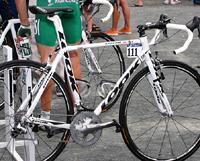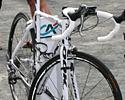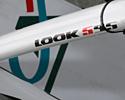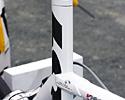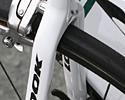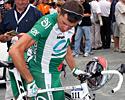
Recently on Cyclingnews.com |
Bikes of the Tour: Pietro Caucchioli's Crédit Agricole Look 595, July 18, 2006Anthony Tan gets a first look at the bike its makers are calling the big brother to the successful Look 585Big brother
One of the first in the world to receive this - maybe even the first - Look's all-new 595 frame and HSC 6 fork was given to Crédit Agricole's GC man Pietro Caucchioli and sprinter Thor Hushovd just before the start of the Tour de France in Strasbourg. This is the eighth successive year Look has been a partner of Crédit Agricole, and the team's riders are almost always the first to ride or test their latest offerings. The 595 is their most recent carbon model, and is also the first to employ nanotechnology in its tubing. So advanced is the technology, the company refers to their workers as 'high-tech craftsmen', with the 595 and 585 framesets requiring 30 man hours to produce. This may seem like a lot - and it is - but Look's Athens 496 track frame took over 100 hours to make! So far, only Caucchioli and Hushovd have the 595 in their possession, but next year, all Crédit Agricole team riders will be equipped with this new model. According to Look, resin 'enriched' with carbon nanotubes allows for increased cohesion between the layer of carbon fibre. The nanotubes also result in stronger lugs, and over time, nanotubes offer greater durability. While dubbed the 'Big brother of the 585' by the company's marketing execs, the 595 bears quite a difference to its predecessor. The integrated seat-tube/seatpost is without a doubt one of the most striking features - but upon closer inspection, the shaped tubes are equally different from the 585, designed to optimise lateral rigidity while retaining vertical flexibility; 'a comfort guarantee', says Look. To save weight, rear dropouts are no longer in aluminium but in carbon, and are directly compressed during moulding of the chain and seat stays, with the result a 'monobloc' wishbone rear triangle. Such technology has already been used with the HSC 5 fork, and also in the HSC 6, Look's latest monobloc fork. Using VHM (very high modulus) carbon, the HSC 6 weighs a scant 315 grams (20 more than the HSC 5), but a new innovation has increased its solidity with negligible weight gain. The base of the fork crown - often a critical point of failure with carbon forks, as there are more carbon fibres running lengthwise - has now been oversized to accommodate at 1/4-inch bearing, increasing its resistance to fatigue. Like the HSC 5 SL, the drop-outs are in moulded carbon, compressed into the fork, and a conical flange enables the bearing to be positioned directly on the fork crown. Total weight of frame alone is an impressive 1,080 grams (size medium, uncut seatpost), with the frame and fork together 1,395 grams. 20 years of making carbon framesThe French firm based in Nevers began making carbon frames in 1986, way before the material became popular, and this year marks the company's 20th year of innovation in this now-crowded arena. Pedals are also close to Look's heart; Look claims more than seven million bikes around the world are equipped with its pedals, with the latest clipless design, named KéO, winning a Design Oscar in 2004. As of June 30, the close of Look's fiscal year, the company's turnover was 29.5 million Euros - a 150 percent increase over an eight-year period, and in France, their sales accounted for six percent of all bikes sold. In 1998, 4,000 frames were produced; today, that figure is 14,000. The time line is significant, as it was July 1998 when chairman and CEO, Dominique Bergin, entered into a partnership to buy out the firm, with Thierry Fournier appointed as general manager. 80 percent of Look's capital continues to be held by Bergin and Fournier, the remainder shared between their staff. Still operating out of Nevers with 135 staff, almost double that number now work out of the new factory in Tunisia, created in 2001. Now, the original site concentrates exclusively on the production of pedals, accessories and finishing of frames. And unlike the situation eight years ago, 70 percent of Look's turnover is now geared towards the export market, with the United States their largest customer, representing roughly one-quarter of overall sales. PhotographyFor a thumbnail gallery of these images, click here Images by Anthony Tan/Cyclingnews
|

